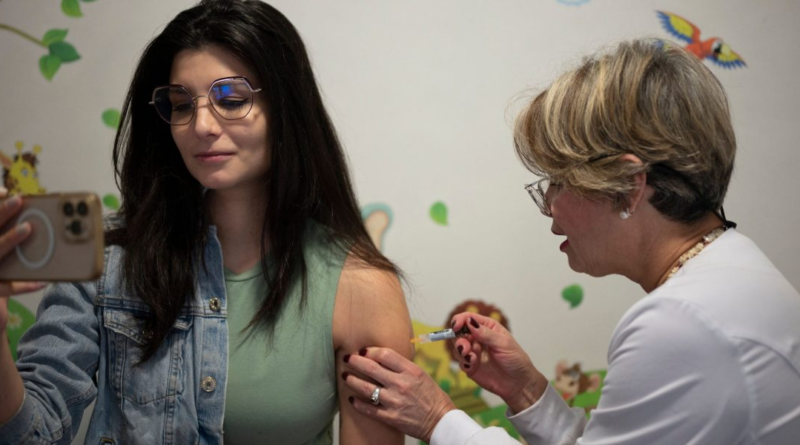Cancer vaccines are already a reality. Here's what you need to know about the cutting-edge technology that could usher in an era of personalized medicine
Cancer vaccines are already a reality. Here’s what you need to know about the cutting-edge technology that could usher in an era of personalized medicine
Cancer vaccines have made headlines as of late, with the U.S. National Institutes of Health recently announcing that personalized vaccines prevented an ultra-deadly pancreatic cancer from returning in about half of trial participants.
What’s more, pharma giants BioNTech and Moderna recently said they’ll explore the potential of mRNA vaccines—first employed with COVID—to fight the disease, one of the leading killers worldwide.
The concept may seem torn from the plot of some futuristic sci-fi movie, or from the pages of some decades-old utopian novel far ahead of its time. But such wonders of science exist today—most in trials, and only a handful actually approved to prevent cancer. Still, while much work lies ahead, such vaccines have been preventing disease and saving lives for more than four decades already.
“If you took a poll and asked people, ‘Do we have a vaccine against cancer?’ people would say no,” Karen Knudsen, CEO of the American Cancer Society, recently told Fortune.
“They really don’t know that we do.”
Just what are cancer vaccines—and what do they do, if not all of them prevent the initial onset of the disease? Whether you’re a cancer patient or not, here’s what you need to know to educate yourself on the topic—because your doctor may not, experts warned Fortune.
What is a cancer vaccine?
Cancer vaccines are not much different from vaccines for infectious diseases like the flu, measles, mumps, and COVID, Dr. Keith Knutson, a professor of immunology at the Mayo Clinic who researches and develops cancer vaccines, recently told Fortune.
Vaccines stimulate the immune system to fight a target—usually a virus. In this case, however, the target is cancer.
Right now, the bulk of cancer vaccines are therapeutic—used to treat patients who already have advanced cancer, often in concert with other interventions like chemotherapy, surgery, or radiation. Two are currently approved by the FDA, according to the Cancer Research Institute: one for early-stage bladder cancer, and another for prostate cancer.
But there are also vaccines for cancer survivors. They’re given to those in remission with a high risk of relapse, Knutson said.
Then there are the vaccines that can prevent cancer altogether. There are four that are FDA approved: three for HPV, or human papillomavirus, and one for Hepatitis B. All work to prevent infections that can lead to cancer down the road. The HPV vaccine is recommended for males and females around age 11 or 12, but can be given as early as 9, and as old as 26. The Hep B vaccine is recommended for everyone age 59 and younger, and adults 60 and older who are at risk for infection.
While approved cancer-preventing vaccines are few in number, they’re having an outsize impact. The HPV vaccine drove a 65% decline in cervical cancer for women in their early 20s from 2012-2019, according to data released this year by the American Cancer Society. Such women would have been among the first to receive the vaccine, approved by the FDA in 2006.
Similar reductions should eventually be seen in other cancers caused by HPV that usually occur later in life, like head, neck, oral, rectal, and vulvar cancers, according to Knudsen.
“It’s a major win for science,” she said, referencing the new data on the vaccine’s success. “We really can end cervical cancer as we know it for everyone, if vaccination happens”—and the same should hold true for other HPV-related cancers.
Another target many researchers have their eyes on: breast cancer. Labs around the world, including Knutson’s, are particularly interested in developing vaccines that could prevent the most common cancer in the world—or at least prevent it from returning in survivors.
Knutson’s lab is working on a vaccine that targets six points of attack frequently found on breast cancer. Fortuitously, many are also found in lung, ovarian, and pancreatic cancers.
“We may be generating immunity that targets breast cancer specifically, but we think that immunity may also be protective against other cancers as well,” he said.
How cancer vaccines work
At the moment, vaccines that treat active cancer exist in trials, with few exceptions. They’re not cures, however—and receiving one is much more complicated than going to a pharmacy and getting a COVID or flu vaccine.
Personalized cancer vaccines are common within clinical trials. But developing them is a lengthy process. And as Dr. Phillip Febbo, chief medical officer at biotechnology company Illumina, told Fortune, “Cancer doesn’t wait.”
Febbo calls personalized cancer vaccines “bespoke therapies.” For each patient, a specialist must determine which tumors can be reached via a biopsy. Then the patient must undergo the biopsy and have their tumor cells genetically sequenced by a company like Illumina. The sequence is analyzed to determine what vaccine composition is likely to be most effective in the particular patient. Then the personalized vaccine must be produced and delivered to the patient.
Each step can take weeks, if not months—usually about six months in all, according to Knutson. Time is “something we’re struggling with on a daily basis,” he says.
Illumina is providing genetic sequencing capabilities to Moderna for its melanoma-prevention vaccine, given to those who’ve been diagnosed and had their tumors removed, Febbo said in February.
Patients who took both their new vaccine and Merck’s Keytruda, a monoclonal antibody therapy that helps immune cells kill cancer cells, were 44% less likely to die or have their cancer return, when compared to a group that took only Keytruda, the companies announced in December. The drug was moving on to a Phase 3 trial, the last before potential FDA approval.
Febbo’s company has reduced the time of whole genome sequencing to around one day, instead of weeks, he said—a move that facilitates quicker delivery of custom vaccines.
Knudsen, Knutson, and others are intrigued by the apparent success of Moderna’s cancer vaccine. They’re hopeful that mRNA technology is the key to speeding up the process of personalizing cancer vaccines—the side effects of which are much more bearable than that of chemo.
“We’re in a new era now, having just seen mRNA vaccines,” Knudsen said. “Is mRNA vaccine technology a new frontier for us? It’s still an open question.”
How to get a cancer vaccine
The future of cancer vaccines is bright, experts say—but perhaps not equally bright for everyone.
All experts Fortune has spoken to expressed worries that new medical technologies like cancer vaccines could disproportionately benefit the privileged—and remain out of reach for many members of marginalized populations.
It’s a trend seen in clinical trials in general, and one that isn’t new to health care, Dr. Nina Bhardwaj, director of immunotherapy at the Vaccine and Cell Therapy Laboratory and co-director of the Cancer Immunology Program at the Icahn School of Medicine at Mount Sinai in New York City, told Fortune.
Biases, unconscious and otherwise, exist—often against non-white patients, women, and older individuals. Due to this, doctors may not recommend clinical trials or some treatments, and “patients need to advocate for themselves,” she said.
Case in point: Black men are around twice as likely to die of prostate cancer than white men. “Some of that is because we don’t understand enough about the genetics of risk,” she said. “But some of it is lack of access to care and clinical trials,” which offer “the most advanced form of care.”
If patients are interested in vaccines that may exist for their cancer—approved or in clinical trial—they shouldn’t wait for their oncologist to bring up the possibility, experts tell Fortune.
“Ask, ‘Am I eligible? What would the benefits and concerns be? What are my treatment options?’” Knudsen advised. “Get a second opinion when you can.”
How close are we to widespread availability of cancer vaccines?
The bulk of current cancer vaccines are for those with advanced disease. It’s the “natural progression of medicine” to start with those most in need, Febbo said. “We make progress, and then we take that progress and march up earlier and earlier” in disease stage.
Knutson predicts a growing number of therapeutic cancer vaccines will be developed over the next decade. There are many ongoing Phase 2 and some Phase 3 clinical trials for such, meaning more help should be on the way relatively soon, he said—with an emphasis on “should.”
Sometimes, the issue isn’t a lack of new successful treatments, but a lack of funding to carry them through to the finish line.
“Part of the problem is, and continues to be—in all realms, whether cancer vaccine or some other kind of treatment—that somebody needs to pick up the (cost of the) higher level clinical studies,” like Phase 3 trials, he said.
“An academic like myself can probably get through Phase 1 or 2 and show promising results, but the competitive landscape and what’s popular amongst investors and what’s not determines whether one goes to Phase 3 clinical trials.”
There’s “no question a lot of opportunities have been missed” throughout the years, Knutson said. In a worst-case scenario, his team develops a successful cancer vaccine but can’t secure the resources for a Phase 3 trial, necessary for FDA approval.
In such a circumstance, he finds it encouraging that future researchers will be able to build upon the progress his team made by reading their publishing findings.
“Although it may be disheartening that I may not see this particular vaccine or that particular vaccine move forward, I’ll know that I’ve contributed to a scientific basis that guides the future,” he said.


